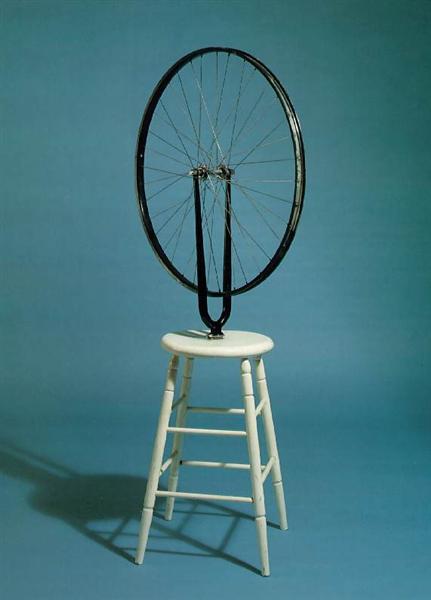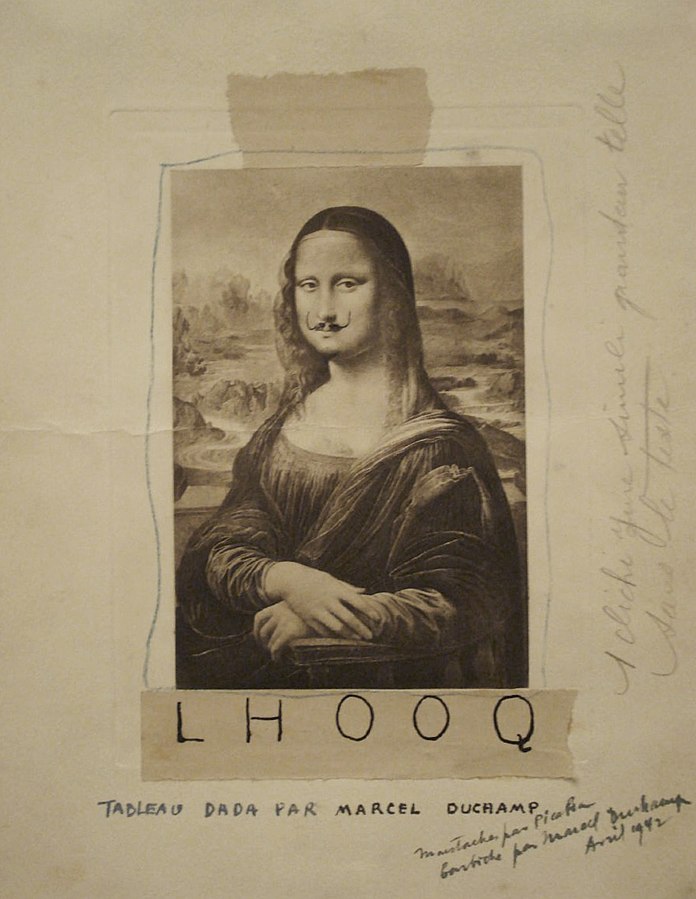Marcel Duchamp (1887-1968) was a French-American painter, sculptor, chess player, and writer. He stirred controversy and influence and had a major impact on the development of conceptual art. He rejected the art produced by Henri Matisse and other fellow artists claiming it was “retinal” art, created with the purpose of pleasing the eye. Duchamp’s objective was quite different. His intention was to create art for the mind. He favored more intellectual, concept-driven approaches to his artistic process.

Marcel Duchamp, Roue de bicyclette (Bicycle Wheel), , one of his Ready Made works of art, created in 1913. Currently in Israel Museum, Jerusalem, Israel. Photo: Public Domain in the U.S.
Duchamp, who is generally perceived as “the artist who killed painting”, became famous for his new art concept of the ‘ready-made’, exemplified by such art works at Roue de bicyclette (shown above). By displacing a commonplace item from its functional context and designating it as art, Duchamp emphasized its pervasiveness and makes a social comment at the same time.
During his short career Duchamp produced very little artwork and he ultimately withdrew from the art world. In later years, Duchamp famously spent his time playing chess.
Although Duchamp broke away from his contemporaries there is no doubt that he had a strong influence on American artists in Pop art including Robert Rauschenberg, Andy Warhol, Jasper Johns, and many others.
He Enjoyed Poking Fun at Mass Production

Marcel Duchamp, 1919, L.H.O.O.Q. First conceived in 1919. Photo: Public Domain in the U.S.
His art work L.H.O.O.Q. the objet trouvé (“found object”) is a cheap postcard reproduction of Leonardo da Vinci’s “Mona Lisa” onto which Duchamp drew a mustache and beard in pencil and changed the title. The name of the piece is a pun; the letters pronounced in French sound like “Elle a chaud au cul”… translation: “She is hot in the arse”.
Duchamp is known for his humorous approach to creating art. Although he began his experiments in the beginnings of an industrialized world, his method of poking fun at the disposable, mass-produced nature of society is just as relevant now as it ever was.
Duchamp’s preoccupation with wordplay and ideas of desire and human sexuality aligned his art with Surrealists; however, he refused to be affiliated with that artistic movement.

Marcel Duchamp, Nu descendant l’escalier n°2. oil on canvas, 57 7/8″ x 35 1/8″. Philadelphia Museum of Art, The Louise and Walter Arensberg Collection. Photo: Public Domain.
The painting titled “Nude Descending a Staircase, No. 2”, depicts the mechanistic motion of a nude, with superimposed facets, similar to motion pictures. It shows elements of both the fragmentation and synthesis of the Cubists, and the movement and dynamism of the Futurists. About this painting Duchamp wrote, “I wanted to create a static image of movement: movement is an abstraction, a deduction articulated within the painting, without our knowing if a real person is or isn’t descending an equally real staircase.”
This was Duchamp’s first painting to provoke the most controversy. It was rejected at the 1911 Salon des Indépendants by his Cubist friends and brothers, including Henri Matisse. He was told to remove it before the opening. After this incident Duchamp has been quoted as saying “I said nothing to my brothers. But I went immediately to the show and took my painting home in a taxi. It was really a turning point in my life, I can assure you. I saw that I would not be very much interested in groups after that.” He later submitted the painting to the 1913 “Armory Show” in New York City.
A Few Quotes by Marcel Duchamp
“I don’t believe in art. I believe in artists.”
“I think that art is the only form of activity through which man shows himself to be a real individual. Through it alone, he can move beyond the animal stage because art opens onto regions dominated by neither time nor space.”
“I have drawn people’s attention to the fact that art is a mirage. A mirage, just like the oasis that appears in the desert. It is very beautiful, until the moment when you die of thirst, obviously. But we do not die of thirst in the field of art. The mirage has substance.”
“The individual, man as a man, man as a brain, if you like, interests me more than what he makes, because I’ve noticed that most artists only repeat themselves.”
“Everything important that I have done can be put into a little suitcase.”
Hi, I was wondering if you knew anything about the impact Duchamp had on the art world? Would be appreciated if you could give me some information,
Thankyou 🙂
Paris, in addition to reading this article you can find out more about Marcel Duchamp and how he challenged the very notion of what art is and his impact on the art world by visiting the Metropolitan Museum of Art website: https://www.metmuseum.org/toah/hd/duch/hd_duch.htm, Encyclopedia Brittanica: https://www.britannica.com/biography/Marcel-Duchamp; and https://www.theartstory.org/artist-duchamp-marcel.htm to name a few. I hope this information helps you.
HI may I know the quote about Duchamp? The meaning is about when you are keep to frighting, you will not make fun of that. I wanna know the exact wording because I am a university art student and I need to finish my project. Thanks a lot!!
Dear Yan Chan, Thank you for your interest in this article. Sorry, I don’t have on hand the complete quote you refer to. When writing the article we used several different sources. You can find links to his biography and his quotes here.
Thank you for this article, many of my pieces were inspired by him and I have spent much of my life trying to move found object to the next step.